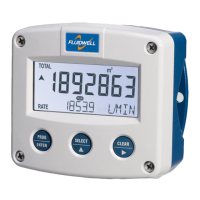FW_F115-P_M_v2201-01_EN.docx
4.5 ELECTRICAL INSTALLATION
• Electro static discharge does inflict irreparable damage to electronics! Before installing or
opening the F115-P, the installer has to discharge himself by touching a well-grounded
object.
• For reasons of ESD and safety, always ground the metal enclosure properly as indicated,
especially if the unit has been supplied with the 115-230V AC power-supply type PM or
relays type OR. It is the responsibility of the installer to install, connect and test the
Protective Earth connections in accordance with the (inter)national Rules and
Regulations.
• This chapter shows general information regarding the electrical installation of the F115-P.
Chapter 5 gives additional specific information regarding Intrinsically safe installation and
overrules the information given in this chapter.
• Do not combine metal front covers with non-metallic rear covers, vice versa and / or
cable glands. A metal cover on a non-metallic rear cover could lead to ESD. A metal
cable gland in a non-metallic enclosure could invalidate isolation.
• The installation must comply with (inter)national requirements and local ordinances.
o Within the European Union and the UK, all installations must comply with national
regulations.
o Within Canada all field wiring must conform to Section 18-156 of the Canadian
Electrical Code for installations within Canada.
o Within the United States all field wiring must conform to the National Electric Code,
NFPA 70, Article 501-4(b).
4.5.1 ELECTRICAL SAFETY
Please consult the table with environmental conditions and safety parameters shown at the
beginning of this chapter.
General directions
• Use (separate) cable glands with effective IP67 / TYPE 4(X) seals for all wires.
• For unused cable entries, fit blind plugs with effective IP67 / TYPE 4(X) seals.
• Make a reliable ground connection to the metal enclosure.
• Use effective screened cable for the input/output signals and provide grounding of its screen to
terminal) or at the external device itself,
whichever is appropriate to the application. Be careful not to create ground loops!
• All wiring must be in accordance with local codes and regulations.
• When an external power supply is used, it must be an approved ELV source, insulated from AC
mains by double / reinforced insulation per CSA C22.2 No. 61010-1-04 / UL61010-1.
All other inputs and outputs shall at least be reinforced insulated from mains.
4.5.2 PROTECTIVE EARTH (PE) CONNECTIONS
Inside the unit, different types of bonding and earthing are used. The common ground is mostly used
for termination of the wire shields; the Protective Earth (PE) is used for electrical safety.
For externally powered installations, route the Protective Earth (PE) grounding conductor into the
enclosure together with the incoming power conductors.
Risk of damage to equipment!
Be very careful when connecting terminal 00 / GND to Protective Earth (PE), as this terminal
is internally connected to the common ground of the system.
Connecting the common ground to Protective Earth (PE) (especially when multiple power
supplies are connected) can cause ground loop currents that could damage the equipment.
Metal enclosure
When the F115-P is supplied with a metal enclosure (aluminum or stainless steel), the enclosure
must be grounded in accordance with national and local electrical codes.
To ground the field mounted unit, the PE conductor must be connected to the PE stud which is
located in the metal back cover, as indicated in the image below. To connect the conductor, a screw
(M4 x 6mm) with a serrated washer, a terminal and a washer is used (torque: 2 Nm). The metal front
cover is connected to the Protective Earth by the mounting screws with serrated washers.
To ground the panel mounted unit, the PE conductor must be connected to the metal front cover
through one of the four mounting screws. For this purpose, an additional nut, terminal and washer is
supplied.

